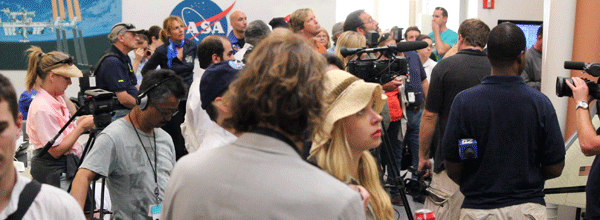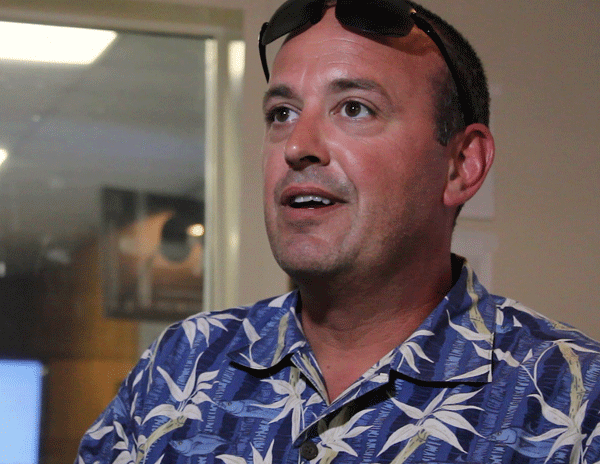Live at NASA TV for the Launch of Space Shuttle Endeavour
Anthony Burokas goes behind the scenes at NASA TV to shadow an event video crew that's responsible for bringing launches live to the world.
Scrub
As we all know from 30 years of shuttle launches, they may get delayed for any number of reasons-from weather, to other activity at the space station, to technical issues. As I was on site gathering footage of the astronauts on their way to the shuttle, I heard the word "scrub"-a word I did not want to hear. It means the launch will not happen.
In this case the culprit was an auxiliary power unit heater that was failing to work properly. NASA ordered the astronauts to return to the astronaut quarters. The KSC TV crew found out only when the information was announced. NASA TV then has to put aside the script they use for the launch broadcast and scramble to provide new information for an information-hungry public.
I walked through the press area and it was as tight as an elevator with people who came in from their own press areas and tents outside. They were now crowded in one room typing away or staring at the NASA TV screens for more information as to why the launch was scrubbed.

The KSC TV press area
NASA TV itself has to find NASA representatives ready and able to speak to why the launch was scrubbed. In Firing Room 4 of the NASA's Launch Control Center we spent much of our time listening to one man: George Diller, Launch Commentator for NASA Public Affairs. He gave event-by-event description of what we are seeing. He also handles most of the on-camera interviews held in Firing Room 4. But NASA TV producers must quickly try and arrange for someone to fill the knowledge void when a launch is scrubbed. In reality, a scrub is more "live TV" than a launch where everything happens according to a plan. Being prepared to handle mishaps is the nature of live TV.
I heard the producers speaking about someone who could speak on camera, but who needed to wait because, as the information was coming in to them, there were more questions. It would take more time to gather all the information the public would want to know about this scrub, the technical issue, and issues regarding rescheduling the launch.
Like many of us who work in live TV, the producer juggled communications with dozens of connections and two different phones all at the same time in order to make things happen. Add to this confusion the public knowledge that President Obama was due to attend the launch. Would he still come? What would he do now? Where would he go? So many questions all at once. The urgency in the room was palpable.
On top of this, the crews in the field must be recalled, and their gear stowed, or redirected for the press conference that follows any scrub related to a technical issue. How many hours on? Is first in first back out? When will the press conference be? Who gets sent home? Who stays? Does this sound like a typical live production? Not to me. Because most live shows are not open-ended like this. They have a fixed start and end time. Even sporting events almost always have a typical run time.
Directing the Show
In speaking with Dmitri Gerondidakis, director of KSC TV, I found that his excitement about the launch was contagious. Like any live show, or even an edit session, he spoke of the countdown creating excitement, how it affects the cuts-they come faster. He stands up to direct the show, snaps his fingers to cue the technical director (TD). And when a launch is scrubbed in those last few minutes, it's as hard for the entire live crew as it is the viewers-maybe even harder because they are there and are looking forward to feeling the energy of the launch throughout their bodies.

KSC TV director Dmitri Gerondidakis
There is a script, with certain shots they need to cover, such as the astronauts walking out and boarding the bus that takes them to the launch pad. But there are also restrictions on the NASA TV crews that make their job a bit harder.
For instance, all the cameras can't be live all the time. Cameras in certain areas have to be off until the proper time. Then they can be turned on. They have but a moment to get a white balance, focus, and steady-up, and then the action happens. The script says the walkabout is supposed to happen at 1:40, but the time always varies depending on how fast the astronauts suited up, and so forth. When the director sees the camera turn on and get ready, they know the shot is about to happen and he needs to get ready to call it up, or miss it entirely.
But when the events happen all according to plan and the launch progresses without issue, taking humankind up into the heavens, there is a great feeling throughout all the workers here. They may not be directly assisting with the launch itself, but they are responsible for sharing the experience, as much as possible, with audiences around the world.